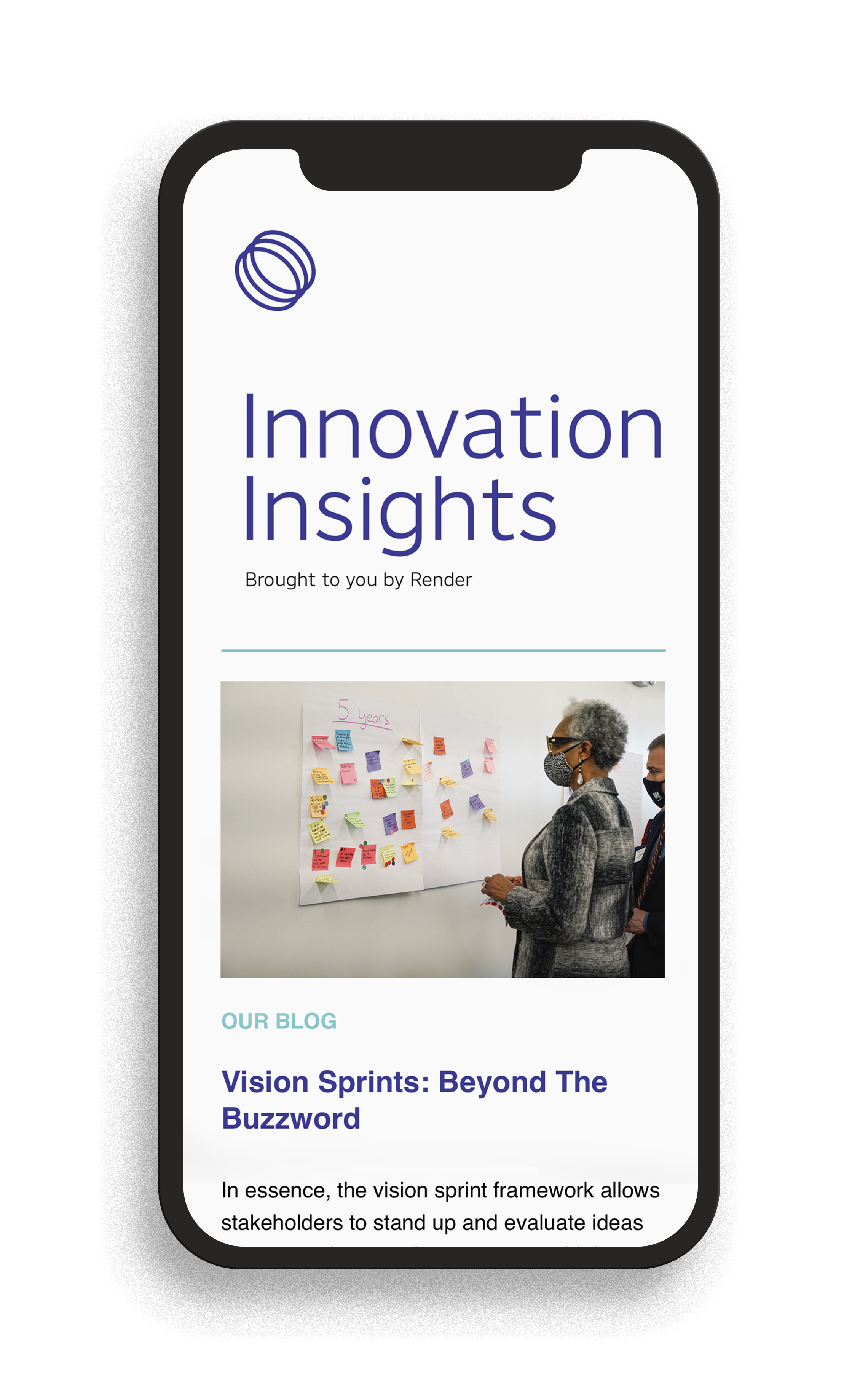When a client comes to us for help with something new, one of our tools we consider using in the early stages is a Render vision sprint. There is no faster, more efficient way to clarify purpose and priorities and ensure we all agree on a general direction for whatever it is that we’re about to take on together. The vision sprint output becomes the compass bearing for our collective work, and it keeps us from drifting away from our original goals. If you’ve ever been a part of a large project involving many stakeholders over a significant period of time (months to years), you know this is not always easy. We use the vision sprint as a tool frequently, but I’m always surprised by how it comes into play in different ways for different clients in the context of a bigger project, so we’ll take a look at how three different cases ended up benefiting from a sprint through the duration of our engagement.
Client 1: The Tortoise
The Problem
The Tortoise has been in business for decades, steadily growing and expanding by adding multiple ventures and business lines that exist largely independently. As a result, they struggled to tell a cohesive story that centered their client population while still encapsulating the breadth of their impact to varied stakeholders.
How we used the Vision Sprint
We reached for the vision sprint tool after an early discussion with the (large) leadership team about the organization’s most important stories started feeling distinctly like there were too many cooks in the kitchen. Decision-makers from each independent business line understandably had their own differing views about the organization’s purpose and biggest achievements–they had been doing great work in parallel for many years, and often had little or no idea what the other departments were taking on. We designed a half-day vision sprint to force difficult decision-making about key audiences and objectives for storytelling about the organization as a whole.
Throughout the next six months, we helped the Tortoise develop branded presentations, launch a new cohesive website, and be better champions for their own work. Whenever disagreements arose about the way forward for messaging (inevitable in any project, but particularly frequent in this one), we were able to reference our original objectives from the vision sprint–which leadership had already endorsed and agreed upon–and adjust to remain on course.
Client 2: The Squirrel
The Problem
The Squirrel is an independent franchise of an internationally-recognized brand looking to pivot away from a legacy business model that no longer served the needs of its membership.
How we used the Vision Sprint
The Squirrel had survived by leveraging a powerful umbrella brand but had not updated their approach to member recruitment and engagement since the dawn of the internet. New leadership was aware of the need to modernize and was willing to entertain wild ideas–something we generally love in a client–until we don’t. As we understood more about the Squirrel’s needs, we realized that leadership’s openness to new directions was driving a lack of focus, and trials of new models were half-hearted and under-resourced, making it difficult to understand whether or not they were feasible solutions.
We leaned on a three-hour vision sprint with the Squirrel’s Board of Directors to distill sustainability efforts into two workstreams, bound by timelines and measurable performance indicators. Go-or-no-go decisions could be supported by meaningful data, and the board could see a clear, coordinated path forward for exploring sustainability. Using the roadmap created through the spring, shiny new ideas could be recorded and fed into a pipeline for consideration in the future without distracting the entire organization and diluting available resources.
Client 3: The Tiger
The Problem
The Tiger had been slow to launch a new initiative despite more-than-sufficient resources and unanimous buy-in, in part because it came fraught with internal politics surrounding ownership and priorities.
How we used the Vision Sprint
The Tiger’s case is a good example of how the process of undertaking the vision sprint can sometimes provide as much value as the sprint itself. Momentum around the new initiative started strong with media fanfare and community excitement, but dissipated in the lull created by slow progress. Leadership in the Tiger’s loosely matrixed organization could not agree on reporting lines, budgeting, and general accountability for the project, so despite widespread support, it languished. To re-ignite momentum and gain clarity around who would own critical pieces of the initiative, we looked to the vision sprint.
We’ve talked about the importance of the sprint decision-maker before, and in this case, it was pivotal. Under the mantle of setting up the sprint, we were able to individually poll stakeholders about who among them they thought could effectively weigh all points of view during the vision sprint–someone who cared about this initiative’s success no matter who owned it–and stakeholders were in general agreement about who this person was. Interestingly, this person had not been put forth in more public discussions surrounding who could lead the initiative.
With the decision-maker’s support, we led the Tiger’s stakeholders through a full day vision sprint to create a clear list of next steps and objectives for the new initiative. The decision-maker’s ability to navigate political friction was on display all day, and the Tigers left the sprint with a new plan and its clear owner.

Vision Sprints in Practice
We use the Render vision sprint as a tool frequently, but I’m always surprised by how it comes into play in different ways for different clients in the context of a bigger project, so we’ll take a look at how three different cases ended up benefiting from a sprint through the duration of our engagement.
Director of Product

Interested in knowing more?
Subscribe to Innovation Insights to stay up to date on all things Render. Get first access to our resources including webinars, case studies, blogs, and more.

Build Your Network Before You Need It
Building a robust network isn't a last-minute endeavor undertaken when opportunity knocks. It's a conscious, long-term investment that requ...

May 24, 2024
What is a Certified Service Disabled Veteran Owned Business (SDVOSB)?
Service-disabled veteran-owned small businesses (SDVOSBs) are transforming the business landscape. From my own journey as a veteran, there ...

May 15, 2024
Navigating TABA Funding
Learn about Render's role in helping to unlock the potential of TABA funding supplemental to your SBIR/STTR grant. Leverage additional TABA...

